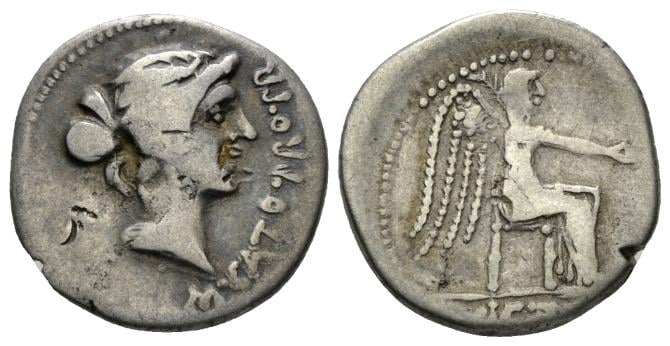Just received 2 pedigreed coins
First is this marvellous republican denarius of Cato the younger
M. Porcius Cato.AR Denarius Africa 47-46 BCE
(18mm., 3.57g).
Obv: M CATO PRO PR Draped female bust r.
Rev: Victory seated r., holding patera.
Babelon Porcia 9. Sydenham 1052. Sear Imperators 46. RBW –. Crawford 462/1c. SRCV 1 (2000) 1381.
From the E.E. Clain Stefanelli collection.
Naville Numismatics 29 February 26 2017 Lot # 560
Next is this very nice Alexandrian Tet of gallienus. It has a great portrait of the emperor and it is an ex: Dattari coin
Egypt, Alexandria. Dattari. Gallienus, 253-268 Tetradrachm circa 267-268 (year 15), billon 23mm., 9.51g. Laureate, draped and cuirassed bust r. Rev. Eagle standing l., holding wreath in beak; behind, palm. Geissen 2944. Dattari-Savio Pl. 273, 10547. Extremely Fine. From the Dattari collection.
Naville Numismatics 29 February 26 2017 Lot # 438
Thanks for looking
Comments
Those are pretty cool! Any info on the collections these came from?
8 Reales Madness Collection
Instagram: 8 Reales Numis
"Elvira E. Clain-Stefanelli (1914-2001) and her husband Dr. Vladimir Clain-Stefanelli (1914-1982) were academic numismatic historians and later numismatic authors and curators. They pursued their interest in ancient coinage of the Black Sea region and U.S. medals as a team, serving together as members of the American Numismatic Society and numerous other national and international numismatic organizations. Vladimir became an ANS Associate in 1951 and a Fellow in 1957; Elvira became a Fellow in 1963. The two were frequent visitors to the Society when they worked for Hesperia Art Galleries and then Stack’s in the 1950s. In 1956 Vladimir became curator of the Smithsonian's Division of Numismatics; a year later, Elvira joined him as Assistant Curator. Together, they built the National Numismatic Collection from approximately 60,000 specimens in 1956 to almost one million objects. Two years after Vladimir's death in 1982, Elvira became the department's first executive director, holding that position until her retirement in 2000.
Dr. Vladimir Clain-Stefanelli (born Waldemar Günther Klein, but later changing the spelling of his surname to Clain and adding Stefanelli, his mother's maiden name) was born in Czernowitz, Bukovina, Austria (now part of the Ukraine and Romania). Vladimir was initially a well-known specialist of Eastern European coinage, in particular of his native Romania. He also specialized in historical documentation of United States coinages as well as coinages of Greek colonies and southeast European issues of the 15th and 16th centuries. Vladimir received a B.A. and M.A. in 1936, and Ph.D. in 1938 from the University of King Carol II in Austria. His 1938 doctoral dissertation, concerning the ancient coinage of Callatis, is included in the collection. Vladimir married the former Elvira Eliza Olinescu on January 3, 1939. After WW II, the couple moved to Italy where they worked for the P&P Santamaria firm. They moved to the United States in 1951, where they would live out the remainder of their lives.
Elvira E. Clain-Stefanelli was born in Bucharest, Romania. She received a degree in history from Franz Josef University in 1936 and later an M.A. in history from the University of Cernauti in Romania. Working with her husband after his appointment as manager of Stack's Coin Galleries subsidiary in 1954, Elvira wrote their first sales catalog. She joined the Smithsonian staff in 1957. In 1973 Elvira, along with her husband, received the Smithsonian Gold Medal for Exceptional Service. In 1996, she received the ANA's Farran Zerbe Memorial Award for Distinguished Service. During her numismatic career, Elvira was advisor to the U.S. Mint, the Department of Treasury, and many boards, committees, and associations.
Together or separately, Elvira and Vladimir Clain-Stefanelli wrote and published many important works including: Monetary history and medallic art at the Smithsonian Institution, Washington, D.C (Numisma, año) (1965); History of the National Numismatic Collections (1968); La monnaie: trésor d’art (1971); Medals Commemorating Battles of the American Revolution (1973); The Beauty and Lore of Coins Currency and Medals (1974); Chartered for Progress, Two Centuries of American Banking: A Pictorial Essay(1975); Muenzen der Neuzeit (1978); Numismatic Bibliography (1984); Life in Republican Rome (1999)."
http://numismatics.org/archives/ark:/53695/nnan0128
Giovanni Dattari was a collector and numismatist of the 19th century. He died in the 1920s. He assembled a complete collection of Alexandrian Tetradrachms of Egypt. His collection was published in a volume in 1901. His collection was several thousand coins. His book (savio-Dattari) is a very important reference book. Indeed, Egyptian tetradrachms are often referred to based on their Dattari number. Coins from this collection are highly sought after. The Ex: Dattari provenance often causes these coins to sell for higher prices than non- Dattari coins. When they do appear at auction there is often much competition for them. This is especially true for the rare coins from the collection.
I am very happy to have a coins from these prestigious collections.